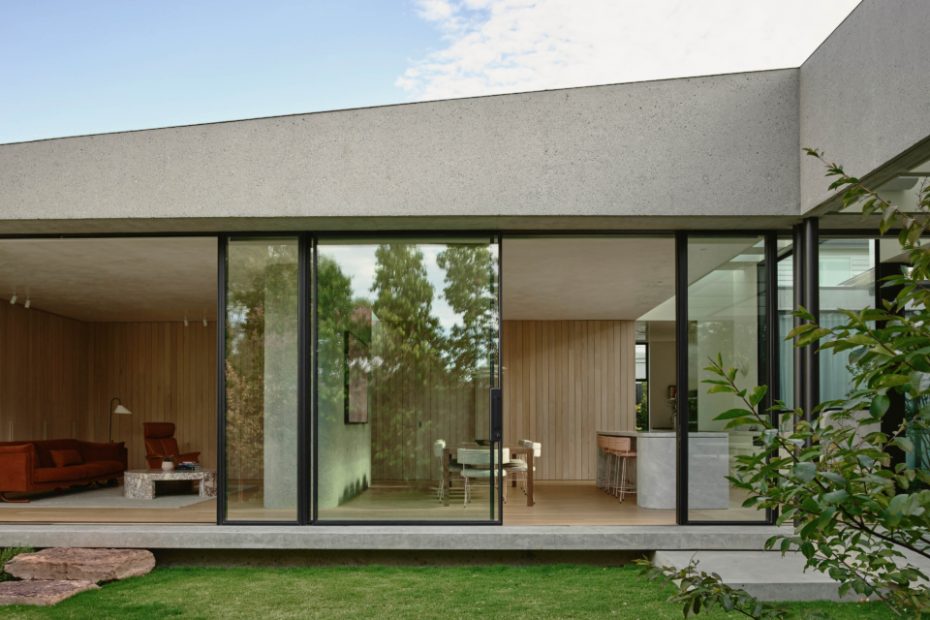Inside A Renovated Victorian Home With Two Courtyard Gardens
Architecture
The kitchen, dining and living areas overlook a lush rear garden.
Concrete was a key material used — a nod to the owner’s father, who was a concreter.
A coffered ceiling runs internally through to the exterior, acting as one big skylight while still providing shelter from the elements.
A central courtyard connects the old and new, serving as a seasonal backdrop that’s visually accessible from the main bedroom, ensuite, walk-in robe, and hallway and kitchen alike.
Concrete also features heavily inside, providing a large thermal mass for passive heating in the cooler months.
Large sliding doors allow for a seamless transition between outside and in.
The owners have a large family and look forward to many years of hosting gatherings and celebrations.
Featuring a ceramic piece by Anne Knights.
Timber was used to give the home a warm, timeless, and robust character.
Timber panelling contrasts the polished plaster ceiling.
The garden is accessed from all angles.
The home is unrecognisable from the 1980s extension that stood before it.
Views through the front windows.
Original fireplaces are still found at the front of the home.
The architects took the detail of a traditional arch and extruded it by 1.2 metres in length, creating a threshold that heightened the experience of transitioning between the old and the new.
All of the bathrooms were updated.
The rear courtyard is also accessed from the side of the propetry.
The historic Victorian facade was repainted and spruced.
Unknown to passers by, this historic Victorian home in Fairfield, Melbourne, hides an impressive contemporary extension.
The more than 100-year-old facade was still in good condition for its age when architecture firm Taylor Knights were enlisted to redesign the property for a local retired couple. It featured classic Victorian architecture with an iron lacework verandah, plus original fireplaces and stained glass windows inside.
Despite this, most of the interiors were outdated and the floorplan was unsuitable for the owners, who wanted a focus on communal entertaining spaces to accommodate their large family. The home also lacked natural light and privacy, and any sort of landscaping in the gardens.
But over the course of 14 months, it was completely transformed. The team at Taylor Knights designed a swish new addition using concrete as the prime material to generate a brutalist feel that contrasts the classic Italianate features at the front (which were also repainted and spruced).
In saying that, there’s still a seamless connection between the old and the new thanks to two significant design features: a large courtyard garden in the centre of the home, and a traditional arched hallway leading from the original entrance through to the new extension.
Architect Peter Knights explains how the central courtyard garden created a striking break between the two forms while allowing light and air into both areas of the home.
‘The design vision was to enhance the connection between the house and its garden by integrating courtyard gardens,’ Peter says. ‘These create a sense of sanctuary, improve privacy, and bring natural light into all internal spaces. Rooms previously deprived of natural light and outlook now have unique seasonal gardens.’
As the open-plan kitchen, living and dining area would serve as the main communal zone for family gatherings, Peter and his team incorporated timber flooring and panelling to evoke a sense of warmth and ensure the home was filled with a timeless and robust character.
By contrast, the concrete finishes add a contemporary element that continues as you wander from the kitchen through large sliding doors to a second courtyard — one that’s open and airy, overlooking the lush landscaped gardens. Perfect for entertaining in the warmer months!
It features a coffered ceiling running from the inside to out, acting as one big skylight and allowing natural light to filter throughout while still providing shelter from the elements.
‘One of the owners’ fathers was a concreter and we wanted to nod the house back to its roots,’ Peter adds. ‘The client also naturally had a strong affinity with the material so it became a prominent feature in the design. The indoor concrete provided a large thermal mass for passive heating in the cooler months.’
Peter says he’s most proud of how the home feels — calm and peaceful. It’s sure to be enjoyed by the owners and their entire family for many years to come!
